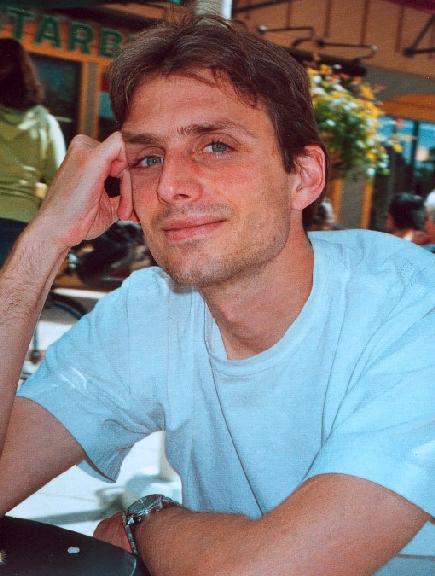
 |
Georg May
Department of Aeronautics & Astronautics |
Background
PhD
Department of Aeronautics and Astronautics, Stanford University (2006)
Dipl.-Ing.
Institut für Luft- und Raumfahrt, RWTH Aachen, Germany (2001)
B.E.
Thayer School of Engineering, Dartmouth College (2000)
Research Interests
High-Order Numerical Methods for conservation laws
Here the focus is on high-order accurate numerical methods for partial differential equations (PDE), in particular those of the hyperbolic type. I am interested in suitable high-order accurate algorithms for general unstructured meshes.There is considerable demand for the numerical solution of differential equations in rather complex computational domains. For example, the Euler or Navier-Stokes equations are routinely solved for full aircraft configuration by lower order methods. This has motivated the use of unstructured mesh technologies, which makes meshing of the computational domain simple, but the formulation of high-order accurate numerical algorithms much more challenging.
Hyperbolic PDE are known to admit discontinuous solutions in finite time, even for smooth initial data. A well known example are the compressible Euler equations, which allow compression shocks for sufficiently high Mach numbers. This leads to shock capturing schemes, which have matured over the years for lower order accuracy, and are widely used in industrial applications. Extensions to high order schemes, however, still leave a lot to be desired.
I have been involved in the development of the Spectral Difference (SD) Method. The SD method uses a local pseudo-spectral representation of the solution on unstructured meshes to achieve arbitrary order of accuracy. Liu, Vinokur and Wang proposed the baseline scheme for hyperbolic PDE in 2004. My own research, which has been carried out at the Aerospace Computing Laboratory at Stanford University in collaboration with Professor ZJ Wang at Iowa State University, has concentrated on the following contributions:
- Investigation of linear and nonlinear stability properties
- Extension of the scheme to the compressible Navier-Stokes equations
- Ensure stability and monotonicity in transonic and supersonic fluid flow through appropriate limiting procedures
Gas-Kinetic schemes for the Navier-Stokes equations
Conventional techniques for the Navier-Stokes equations necessitate the use of different discretization stecils for the inviscid and viscous flux components. While these techniques often have a physically sound motivation, algorithmically it can be quite challenging to discretize the Navier-Stokes equations on general meshes, i.e. arbitrary polyhedra.Gas-Kinetic finite volume schemes offer an attractive alternative in that they allow the discretization of the Navier-Stokes equations on a simple and universal next-neighbor stencil. This is accomplished by applying the discretization to the gas-kinetic distribution function, rather than the macroscopic variables. The connection between the mesoscopic and macroscopic level is established by the governing gas-kinetic equations, i.e. the Boltzmann or BGK equations and related framework from kinetic gas theory, such as the Chapman-Enskog expansion.
The discretization of the Navier Stokes equations can be accomplished by first computing gradients of the macroscopic variables, and subsequent discretization of a reconstructed gas-kinetic distribution function, which is a function of the macroscopic variables and their gradients, and must be consistent to the Navier-Stokes order of accuracy in Chapman-Enskog expansion. Written in terms of the macroscopic variables this amounts to a nonlinear reconstruction and averaging of flow variables and their gradients to approximate convective and viscous fluxes.
Algorithms for general unstructured meshes
I am interested in the software engineering aspects related to creating flexible computational tools for modeling physics on general unstructured meshes. There are numerous challenges related to computational geometry, algorithmic details (such as multigrid techniques) for solvers that operate on arbitrary polyhedral meshes. This is true even for low-order approximations, and for any type of physics problem. In this context I have been involved in the design and developed of a computational architecture for modeling compressible fluid flow on arbitrary polyhedral meshes, designated flo3xx.Publications
2007 | |||
 |
May, G., Jameson, A.: "An improved gas-kinetic BGK finite-volume method for three-dimensional transonic flow" ,J. Comp. Phys. 220(2), pp. 856-878, 2007 | ||
2006 | |||
 |
Wang, Z.J., Liu, Y., May, G., Jameson, A.: "Spectral Difference Method for Unstructured Grids II: Extension to the Euler Equations" , J. Sci. Comput., In Press, Available online | ||
 |
May, G., Jameson, A.: "A Spectral Difference Method for the Euler and Navier-Stokes Equations on Unstructured Meshes", AIAA-2006-0304, 44th AIAA Aerospace Sciences Meeting and Exhibit, January 9-12, 2006, Reno, NV. | ||
